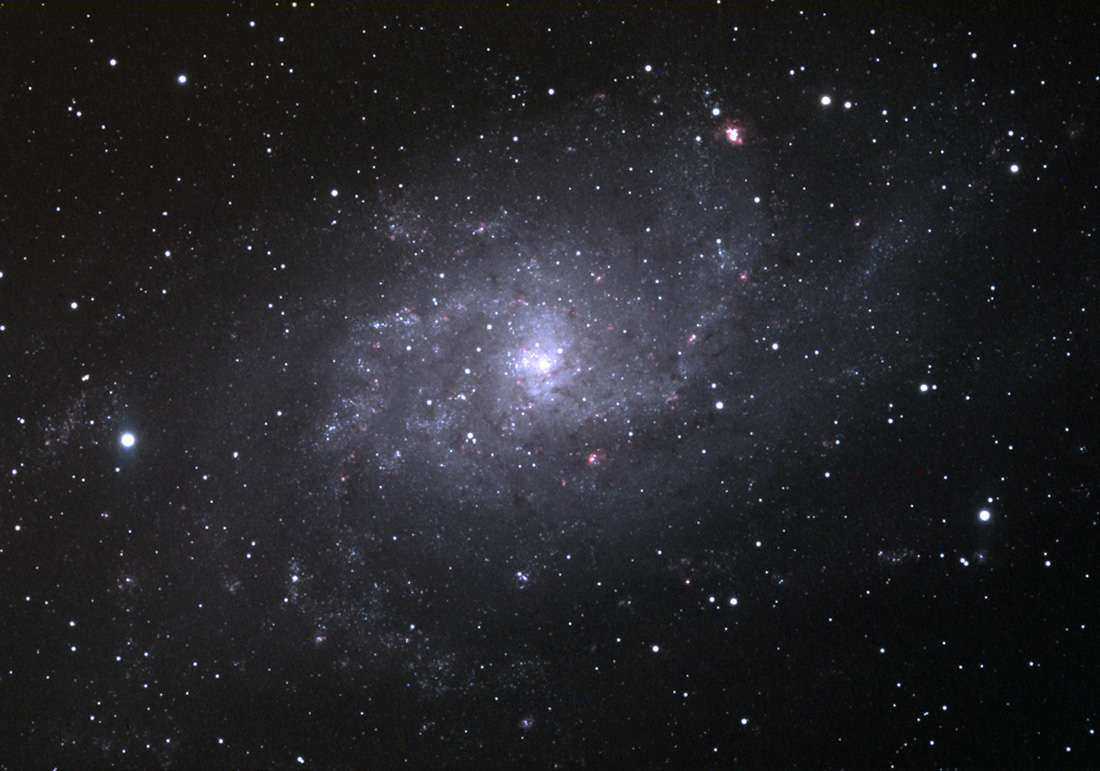
This photograph shows M33, which is known as the Triangulum Galaxy. This galaxy is also sometimes referred to as the Pinwheel Galaxy, although the latter term is usually used to refer to M101. The galaxy shines at magnitude 5.7, although the surface brightness is only about 14.2. Nevertheless, this galaxy can be glimpsed with the naked eye under very dark skies, and is therefore listed in the 1996 edition of the Deep Sky Field Guide as the most distant object visible without optical aid.
The Triangulum Galaxy is gravitationally bound with our Milky Way Galaxy as part of approximately 30 galaxies forming the Local Group of galaxies. It is roughly the same distance away as the Andromeda Galaxy. In fact, the Triangulum Galaxy and Andromeda Galaxy are only about 570,000 light years apart, which is five times closer than either galaxy is to our Milky Way Galaxy. The Triangulum Galaxy is about 60,000 light years in diameter. It gives off a total light output which is 3 billion times that of the Sun. The galaxy is rotating about its center, and completes one rotation every 200 million years. The Triangulum Galaxy has the distinction of being one of the few galaxies that does not show a red shift in its spectrum, meaning that it is not receding from us at a high rate of speed. To the contrary, the Triangulum Galaxy is getting closer at the rate of 7 miles per second.
The red nebula above and to the right of the galaxy core is NGC 604, a giant nebula in M33. The nebula NGC 604 is located 12 arcseconds northeast of the galaxy's center. It is the brightest HII region in M33. The nebula contains several stars of 16th magnitude and fainter. This is a huge nebula that is about 1000 light-years in size. It is one of the largest HII regions known in any galaxy. If it were located as close to us as the Orion Nebula, it would cover a large part of our night sky.
This galaxy was included in the first list published by Charles Messier in 1769.
This is a composite RGB CCD image taken at prime focus on a Takahashi FCT-150 refractor at f7 using an ST-8E CCD. Guiding was accomplished with the built-in ST-8E autoguider.
This image was taken at the Sunglow Ranch, near Pearce, Arizona. Located in southeastern Arizona, the Sunglow Ranch enjoys very dark skies and caters to amateur astronomers. The staff are very friendly. I highly recommend the place to fellow amateur astronomers.
M33 (NGC 598)
Constellation: Triangulum
RA: 01h 33m 52s Dec: +30d 39' 29" (J2000)
June 24, 2001
Image by Sid Leach
Sunglow Ranch, Arizona
Recent Images.
Complete list of images.
Description of equipment used to acquire images.
Home
Feedback and comments should go to Sid